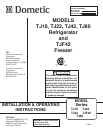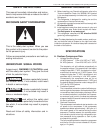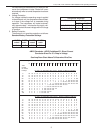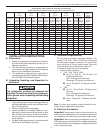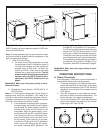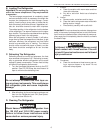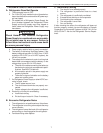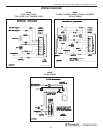
6
TJ18, TJ22, TJ42, TJF42 & TJ80 Installation And Operating Instructions
B. Loading The Refrigerator
Important:
Do not put glass containers holding liq-
uids in the freezer compartment. They may break due
to expansion.
The food storage compartment is completely closed
and non ventilated, which is necessary to maintain the
required low temperature for food storage. Conse-
quently, foods having a strong odor or those that ab-
sorb odors easily should be covered. Vegetables, sal-
ads, etc. should be covered to retain their crispness.
The coldest position in the refrigerator is at the bottom
of the refrigerator. The warmer areas are on the upper
door shelves. This should be considered when placing
different types of food in the refrigerator.
When the refrigerator is heavily loaded, it will take a
longer time to lower the temperature; therefore, to get
maximum efficiency the refrigerator and food items
should be precooled prior to loading. The shelves
should not be covered with paper or plastic, and the
food items should be arranged so air can circulate
freely.
C. Defrosting The Refrigerator
Defrosting should be carried out whenever the frost
layer exceeds a thickness of 1/8". Defrosting is neces-
sary to guarantee efficient refrigeration and to avoid
excessive power consumption. Excess frost buildup
will effect the refrigerator performance.
1. Turn the thermostat adjustment knob to the OFF
position. See FIG. 2B. Keep the door/freezer lid
open to minimize the defrosting time.
Do not attempt to remove the frost layer us-
ing any sharp instruments. This could pierce
the refrigerator plate and cause irreparable
damage.
2. After defrosting, dry the entire interior surfaces, and
then turn the refrigerator back ON. (See Operat-
ing Instructions-Section A.)
D. Cleaning The Refrigerator
Shock Hazard. Disconnect refrigerator from
the 120 VAC and 12/24 VDC power supply.
Failure to follow these instructions could
cause death or serious personal injury.
1. Exterior
a. Clean the exterior with warm water and then
rinse with cold water.
b. Dry with a soft cloth. Avoid use of abrasive
products.
2. Interior
a. Remove racks, containers and ice trays.
b. Clean the interior using warm water mixed with
baking soda or vinegar.
c. Rinse and dry carefully with a soft cloth.
Important: Do not use abrasive products, detergents or
soap. In the case of prolonged disuse, to avoid the forma-
tion of mold or unpleasant odors, disconnect all power sup-
plies, empty the unit completely, clean the interior, and leave
the door/lid ajar.
Cut Hazard. When cleaning condenser, avoid
direct contact with finned section. Fins will
cut and if these instructions are not followed
injury could occur.
3. Condenser
a. Clean the condenser at least once a year us-
ing a vacuum cleaner or dry brush. Do not
clean with sharp objects.
CAUTION
CAUTION
WARNING
!
CAUTION
!



